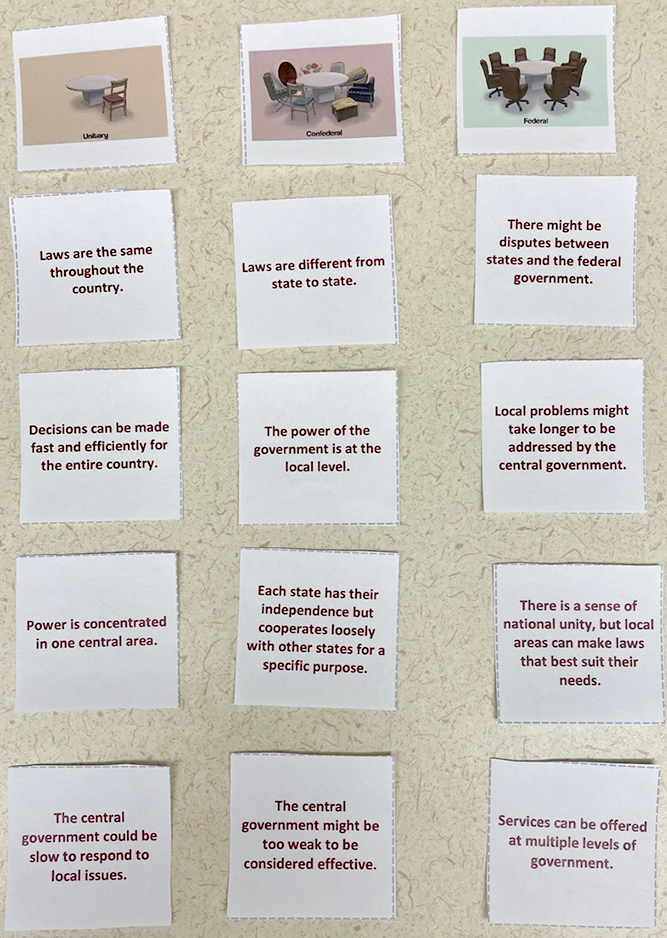Summary
In this lesson, students discover the attributes of three systems of government by discussing advantages and disadvantages of each type, sorting characteristics of each type, reflect on potential issues faced by citizens living under each type of system, and summarize their learning by giving each system a grade with their reasoning.
Essential Question(s)
How do governments distribute power?
Snapshot
Engage
Students reflect on the role of government in people’s lives.
Explore
Students analyze advantages and disadvantages of different governmental systems.
Explain
Students sort characteristics of unitary, confederal, and federal governments.
Extend
Students discuss potential problems different governmental systems face.
Evaluate
Students grade unitary, confederal, and federal governments and provide reasoning for the grades.
Materials
Lesson Slides (attached)
Systems T-Chart handout (attached)
Systems Card Sort handout (attached; optional)
Chat Stations Posters (attached)
Systems Report Card handout (attached)
Scissors (one per group; optional)
Engage
10 Minute(s)
Use the attached Lesson Slides to guide the lesson. Review the essential question on slide 3 and the lesson objectives on side 4 to the extent necessary. Move to slide 5 and read the question to students, what is the role of government in people’s lives? Using the Think-Pair-Share strategy, allow time for students to think of a response before pairing up with a partner and sharing their thoughts.
Ask for several volunteers to share what they have talked about with their partner. Have a short class discussion about the way in which the government is involved in citizen’s lives.
Explore
15 Minute(s)
Place students into groups of three to four. Pass out the attached Systems T-Chart handout to students, each group receives one of the three pages of the handout. Move to slide 6 and tell students to work in their groups to read over the country information. After they read about the country, have students work as a group to write down the advantages and disadvantages the citizens experience from the system of government the described country has.
Ask each group to share something that they have written about their country, until all groups have shared. As students share, take some notes on the whiteboard by creating a heading for each of the three countries and adding information underneath. After students have shared, tell students that each country represents a unique system of government that is either unitary, confederal, and federal. Explain to students that the countries they read about each have a system of government that divides power in different ways. The countries described have the following system:
Country A - Unitary
Country B - Federal
Country C - Confederal
Explain
15 Minute(s)
Pass out the attached Systems Card Sort handout to each group. Have students cut out the cards. Display slide 7 and review the formal definitions of unitary, confederal, and federal systems of governments with students. Have students sort the cards into the appropriate government system.
Circulate and monitor as students complete the card sort, answering questions and clarifying the concept as needed. The image below displays the card sort solution:

Extend
15 Minute(s)
Display slide 8 and tell students they are going to rotate to each poster, read the prompt, and discuss the questions on the poster. Have students choose a poster to begin with and start the timer on slide 8. When time stops, have students move to the next poster until they have visited all the posters. Tell students to return their seats. Ask students to share what they talked about at each poster and have a class discussion about the issues that can arise from the different governmental systems.
Evaluate
20 Minute(s)
Pass out the attached Systems Report Card to each student. Move to slide 9 and have students individually give each of the three systems of government a grade with their reasoning. Collect the handouts to review and check for student understanding of the lesson content.
Resources
K20 Center. (n.d.). Chat Stations. Strategies. https://learn.k20center.ou.edu/strategy/944
K20 Center. (n.d.). Desmos Classroom. Tech tools. https://learn.k20center.ou.edu/tech-tool/1081
K20 Center. (n.d.). Think-Pair-Share. Strategies. https://learn.k20center.ou.edu/strategy/139


